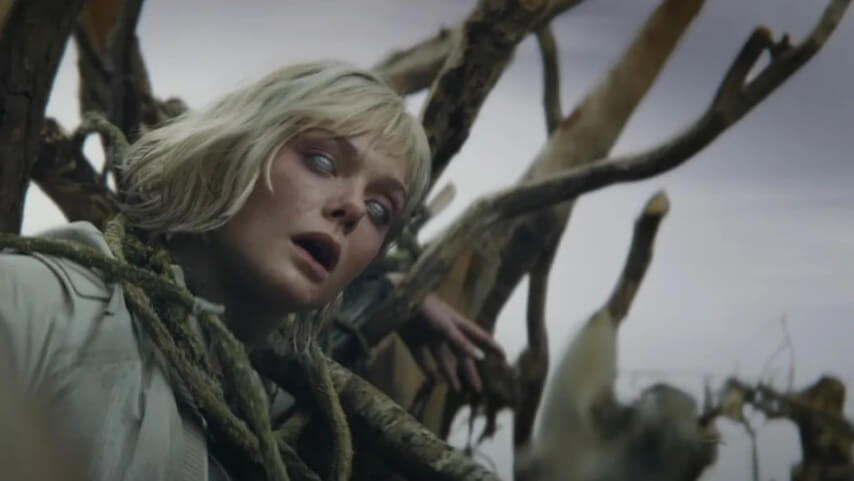Spoiler Space offers thoughts on, and a place to discuss, the plot points we can’t disclose in our official review. This article features plot details of Predator: Badlands.
There are no Xenomorphs in Predator: Badlands. No Chestbursters. No Facehuggers. Nevertheless, the Weyland-Yutani window dressing of the Alien franchise is all over the film, feeding a known entity from one series into another that often lacks specificity. With Badlands, director Dan Trachtenberg colors in Predator‘s mythology with more well-established lore, populating this would-be cinematic universe with synthetics, Power Loaders, and corporate terror. Badlands‘ goal is to turn Predator into the hero. In Weyland-Yutani, it found the perfect villain, a formidable foe for the so-called Killer Of Killers. After all, following a half-century of sci-fi horror, few screen monsters have a greater kill count than Weyland-Yutani.
Predator has long relied on Alien for a little story lift, and the two have been at war for nearly as long as there have been Predator films. Dark Horse debuted the Aliens Vs. Predator comics in 1989, and a Xenomorph skull ended up in Predator 2 the following year. The crossover forced Predator to evolve past the “if it bleeds, we can kill it” descriptor. As Jarrod Jones notes in The A.V. Club‘s review of Badlands, the alien race in Predator didn’t even have a name until a 1994 novelization of the comics. Badlands is the first time “Yautja” has made it to the screen, despite two mid-’00s Alien Vs. Predator movies that did little to give the anonymous Predators some semblance of character. Still, the Predator came out victorious in both films. That’s why Badlands, despite being a crossover, isn’t a rematch. No, it’s time for Predator to take on the final boss: the Company.
Freeing itself of the callbacks and missteps of reboots past, the Predator franchise got its groove back with Trachtenberg’s 2022 film Prey. Around that time, and following Disney’s acquisition of 20th Century Fox, Alien also burst forth with more expansive franchise entries than before. Like Badlands, Noah Hawley’s Alien: Earth TV series is more interested in the corporate entity hunting the Xenomorphs than any specific H.R. Giger creation. If anything, both Earth and Badlands think there’s way more juice (or milk) in the Weyland-Yutani synthetics.
Predator: Badlands sends a young Yautja to the death planet of Genna on a rite-of-passage hunt. To prove himself to his father, Dek (Dimitrius Schuster-Koloamatangi) must kill the Kalisk, a spiky mammoth that can heal wounds and regenerate limbs like Wolverine. Badlands adds this parental pathos while honoring the only thing we’ve ever known about the title creatures: Predators travel the cosmos in search of the most dangerous game. Weyland-Yutani is actually in the same business, seeking out the most powerful predators for its weapons division. The Yautja credo—”Prey to none, friend to none, predator to all”—is probably a more appropriate corporate motto for Weyland-Yutani than “Building better worlds.”
After crash-landing on the planet, Dek links up with the legless Wey-Yu synthetic Thia (Elle Fanning). Designed with greater sensitivity and heightened emotional intelligence than most synths, Thia mirrors Dek’s insecurities about his capacity for empathy and companionship. But screenwriters Patrick Aison and Brian Duffield remember that there are also rules for Synthetics, and they uphold them in subversive ways. Since Ash (Ian Holm) first defied Ripley (Sigourney Weaver) and allowed the Xenomorph aboard the Nostromo, it’s become a trope in Alien movies that, at some point, the often-secret robot will sabotage the crew or be accused of it. Guilty or innocent, the synthetic onboard is always suspect. Badlands inverts this by introducing Thia as a synthetic and complicating her character through her relationships with her sister, Tessa (Fanning), and Weyland-Yutani. She’s not loyal to MU/TH/UR or the company. She’s loyal to her sister. So when she fulfills the cliches of the treacherous synth, it’s not a malevolent calculation, but one that she regrets. Unfortunately, when Tessa betrays her, it reveals another devious truth about the company: Not even their own products are immune to its double-dealing. The Predator may be a ruthless killer who sees empathy as weakness, but at least he isn’t programming robots to feel pain and dropping them in a meat grinder.
The presence of Weyland-Yutani can make Badlands a stressful first watch—namely, because those tired of cynical reboots and expanding universes will simply be waiting for the next egg to hatch. Thankfully, Weyland isn’t hunting Xenomorphs on Genna. Instead, Trachtenberg gives its third-act set piece to another icon of the Alien series: the Power Loader. Tessa takes Ripley’s seat and returns the technology to the company; where Ripley used the Power Loader as a fusion of technology and humanity, Badlands hands it all the heroics to the machine. This leaves Dek to abide by his own Predator tropes: Like Dutch (Arnold Schwarzenegger) from the original Predator, covering himself in mud, Dek clothes himself in nature and uses the environment around him to defeat an enemy overpowered by technology.
Predator: Badlands joins Alien: Earth in recognizing that Weyland-Yutani and its corporate terror is the most malleable piece of the Alien universe. It is the real enemy, the true Killer Of Killers. By finding places where the two film series can intermingle outside of straightforward monster battles, Trachtenberg presents the company’s domination as an extension of the dogmatic ideology Dek wrestles with—elevating their rules to apply to the whole universe. But Weyland-Yutani will always be the most dangerous game; if it doesn’t bleed, no one can kill it.

